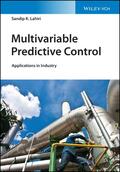Multivariable Predictive Control
Applications in Industry

1. Auflage Oktober 2017
304 Seiten, Hardcover
Wiley & Sons Ltd
A guide to all practical aspects of building, implementing, managing, and maintaining MPC applications in industrial plants
Multivariable Predictive Control: Applications in Industry provides engineers with a thorough understanding of all practical aspects of multivariate predictive control (MPC) applications, as well as expert guidance on how to derive maximum benefit from those systems. Short on theory and long on step-by-step information, it covers everything plant process engineers and control engineers need to know about building, deploying, and managing MPC applications in their companies.
MPC has more than proven itself to be one the most important tools for optimising plant operations on an ongoing basis. Companies, worldwide, across a range of industries are successfully using MPC systems to optimise materials and utility consumption, reduce waste, minimise pollution, and maximise production. Unfortunately, due in part to the lack of practical references, plant engineers are often at a loss as to how to manage and maintain MPC systems once the applications have been installed and the consultants and vendors' reps have left the plant. Written by a chemical engineer with two decades of experience in operations and technical services at petrochemical companies, this book fills that regrettable gap in the professional literature.
* Provides a cost-benefit analysis of typical MPC projects and reviews commercially available MPC software packages
* Details software implementation steps, as well as techniques for successfully evaluating and monitoring software performance once it has been installed
* Features case studies and real-world examples from industries, worldwide, illustrating the advantages and common pitfalls of MPC systems
* Describes MPC application failures in an array of companies, exposes the root causes of those failures, and offers proven safeguards and corrective measures for avoiding similar failures
Multivariable Predictive Control: Applications in Industry is an indispensable resource for plant process engineers and control engineers working in chemical plants, petrochemical companies, and oil refineries in which MPC systems already are operational, or where MPC implementations are being considering.
Table List xix
Preface xxi
1 Introduction of Model Predictive Control 1
1.1 Purpose of Process Control in Chemical Process Industries (CPI) 1
1.2 Shortcomings of Simple Regulatory PID Control 2
1.3 What Is Multivariable Model Predictive Control? 3
1.4 Why Is a Multivariable Model Predictive Optimizing Controller Necessary? 4
1.5 Relevance of Multivariable Predictive Control (MPC) in Chemical Process Industry in Today's Business Environment 6
1.6 Position of MPC in Control Hierarchy 6
1.7 Advantage of Implementing MPC 10
1.8 How Does MPC Extract Benefit? 13
1.9 Application of MPC in Oil Refinery, Petrochemical, Fertilizer, and Chemical Plants, and Related Benefits 17
2 Theoretical Base of MPC 23
2.1 Why MPC? 23
2.2 Variables Used in MPC 25
2.3 Features of MPC 26
2.4 Brief Introduction to Model Predictive Control Techniques 27
3 Historical Development of Different MPC Technology 43
3.1 History of MPC Technology 43
3.2 Points to Consider While Selecting an MPC 52
4 MPC Implementation Steps 55
4.1 Implementing a MPC Controller 55
4.2 Summary of Steps Involved in MPC Projects with Vendor 60
5 Cost-Benefit Analysis of MPC before Implementation 63
5.1 Purpose of Cost-Benefit Analysis of MPC before Implementation 63
5.2 Overview of Cost-Benefit Analysis Procedure 64
5.3 Detailed Benefit Estimation Procedures 65
5.4 Case Studies 73
6 Assessment of Regulatory Base Control Layer in Plants 77
6.1 Failure Mode of Control Loops and Their Remedies 77
6.2 Control Valve Problems 77
6.3 Sensor Problems 82
6.4 Controller Problems 83
6.5 Process?]Related Problems 84
6.6 Human Factor 85
6.7 Control Performance Assessment/Monitoring 86
6.8 Commonly Used Control System Performance KPIs 87
6.9 Tuning for PID Controllers 92
7 Functional Design of MPC Controllers 101
7.1 What Is Functional Design? 101
7.2 Steps in Functional Design 102
8 Preliminary Process Test and Step Test 113
8.1 Pre?]Stepping, or Preliminary Process Test 113
8.2 Step Testing 115
8.3 Development of Step?]Testing Methodology over the Years 120
9 Model Building and System Identification 123
9.1 Introduction to Model Building 123
9.2 Key Issues in Model Identifications 124
9.3 The Basic Steps of System Identification 127
9.4 Model Structures 137
9.5 Common Features of Commercial Identification Packages 142
10 Soft Sensors 145
10.1 What Is a Soft Sensor? 145
10.2 Why Soft Sensors Are Necessary 145
10.3 Types of Soft Sensors 147
10.4 Soft Sensors Development Methodology 149
10.5 Data?]Driven Methods for Soft Sensing 156
10.6 Open Issues and Future Steps of Soft Sensor Development 162
11 Offline Simulation 167
11.1 What Is Offline Simulation? 167
11.2 Purpose of Offline Simulation 167
11.3 Main Task of Offline Simulation 168
11.4 Understanding Different Tuning Parameters of Offline Simulations 168
11.5 Different Steps to Build and Activate Simulator in an Offline PC 176
11.6 Example of Tests Carried out in Simulator 177
11.7 Guidelines for Choosing Tuning Parameters 181
12 Online Deployment of MPC Application in Real Plants 183
12.1 What Is Online Deployment (Controller Commissioning)? 183
12.2 Steps for Controller Commissioning 183
13 Online Controller Tuning 193
13.1 What Is Online MPC Controller Tuning? 193
13.2 Basics of Online Tuning 193
13.3 Guidelines to Choose Different Tuning Parameters 195
14 Why Do Some MPC Applications Fail? 199
14.1 What Went Wrong? 199
14.2 Failure to Build Efficient MPC Application 201
14.3 Contributing Failure Factors of Postimplementation MPC Application 205
14.4 Strategies to Avoid MPC Failures 210
15 MPC Performance Monitoring 221
15.1 Why Performance Assessment of MPC Application Is Necessary 221
15.2 Types of Performance Assessment 222
15.3 Benefit Measurement after MPC Implementation 222
15.4 Parameters to Be Monitored for MPC Performance Evaluation 223
15.5 KPIs to Troubleshoot Poor Performance of Multivariable Controls 228
15.6 Exploitation of Constraints Handling and Maximization of MPC
16 Commercial MPC Vendors and Applications 235
16.1 Basic Modules and Components of Commercial MPC Software 235
16.2 Major Commercial MPC Software 243
16.3 AspenTech and DMCplus 244
16.4 RMPCT by Honeywell 251
16.5 SMOC-Shell Global Solution 253
16.6 Conclusion 261
Index


